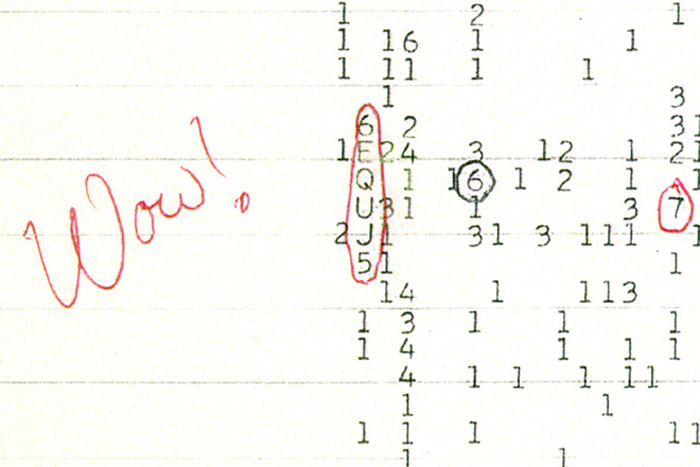Alien 'Wow!' Signal Could Soon be Explained

The story behind the famous "Wow!" signal has an eerie quality that has inspired countless science fiction alien encounters and is often lauded as one of the strongest pieces of evidence that we are, in fact, not alone in the universe.
However, its "alien intelligence" authenticity has been questioned since that fabled night on Aug. 15, 1977 at 10:16 p.m. ET when astronomer Jerry Ehman used the Ohio State University’s Big Ear radio telescope to sweep the skies for signals that may have originated from an extraterrestrial civilization.
On that night, Ehman found something. And since that night, astronomers have been trying to figure out what it means.
MORE: The Wow! Signal: Intercepted Alien Transmission?
While pointed in the direction of 3 star systems named Chi Sagittarii, in the constellation of Sagittarius, Big Ear detected a 72 second radio wave burst, a signal far stronger than background noise. On the observatory’s computer printout, Ehman circled the burst with the infamous annotation "Wow!"
This excitement wasn't an overstatement, it was this kind of signal he was looking for, the kind of signal astronomers thought a technologically-capable alien civilization would produce.
The Big Ear printout contains a bunch of apparently random numbers and letters, but Ehman’s red pen circles a cluster of digits "6EQUJ5" with other circles around a "6" and "7" on separate columns. This particular code first uses the numbers 1-9 and then the alphabet A-Z to denote signal strength. As the burst suggests, the signal strength hit "6" and then blasted through the letters reaching a peak of "U" before subsiding back into the numerical scale at "5." There was then a slight wave trailing the main signal (hence the circled "6″ and "7"). The wave profile of the "Wow!" signal is graphically envisaged here.
Sign up for the Live Science daily newsletter now
Get the world’s most fascinating discoveries delivered straight to your inbox.
However, since that day in 1977, a detection of a signal of that strength has not been replicated. Even after the SETI Institute was founded in 1984, and countless efforts have been made to find another radio burst like the "Wow!" signal, astronomers have been faced with silence in the cosmos; a problem that has only served to intensify the Fermi Paradox unease.
13 Ways to Hunt Intelligent Aliens
Now, Antonio Paris of St Petersburg College, Fla., an ex-analyst of the US Department of Defense, hopes to solve the mystery and he suspects that an entirely different cosmic phenomenon is to blame.
In an interview with TheGuardian.com, Paris says that his investigative background sent him on a mission to find another possible explanation for the "Wow!" signal and he tracked down two "suspicious" comets that may have been in the vicinity of Chi Sagittarii on Aug. 15, 1977. Interestingly, these comets, called 266P/Christensen and 335P/Gibbs, were only discovered in 2006 and 2008, so weren't considered as possible reasons for the signal in 1977 as no one knew of their existence.
But what have comets got to do with errant radio bursts?
The "Wow!" signal was recorded in the 1420MHz radio frequency band. It just so happens that cosmic neutral hydrogen naturally radiates at this frequency — it is therefore an abundant signal that is commonly used in astronomy. This is no coincidence; through alien-hunting logic, should there be an extraterrestrial species wanting to make contact, what frequency would they use? Firstly, as we only have ourselves to use as an alien template, we have to assume that hypothetical aliens will likely use radio waves. Secondly, if they are using radio waves to communicate with us, they would likely use a frequency that other intelligent aliens would be naturally tuned into. 1420MHz is the "universal water cooler," where intelligent life could check into and potentially chat.
ANALYSIS: Seeking the Aliens Who Are Looking Right At Us
The bummer is, however, that comets contain copious amounts of hydrogen in their atmospheres. Say if the "Wow!" signal was actually caused by the chance passage of a comet through the radio telescope's field of view, packing a powerful radio surge?
In 2017, Comet 266P will once again orbit in front of Chi Sagittarii and Comet 335P will do so the following year and Paris wants to test this hypothesis. Unfortunately, existing radio telescopes are already booked, so he has to buy or build his own radio antennae in time for the cosmic encounters. He has a crowdfunding campaign set up to raise the $20,000 he needs and is most of the way there.
It may be a long shot, but as is the way with many astronomical studies, all possible phenomena need to be ruled out before a discovery is made and, should Paris' experiment prove the "Wow!" signal was in fact caused by interference by an undiscovered comet, the universe will get quieter once again, making the Fermi Paradox even more bewildering.
Originally published by Discovery News.









